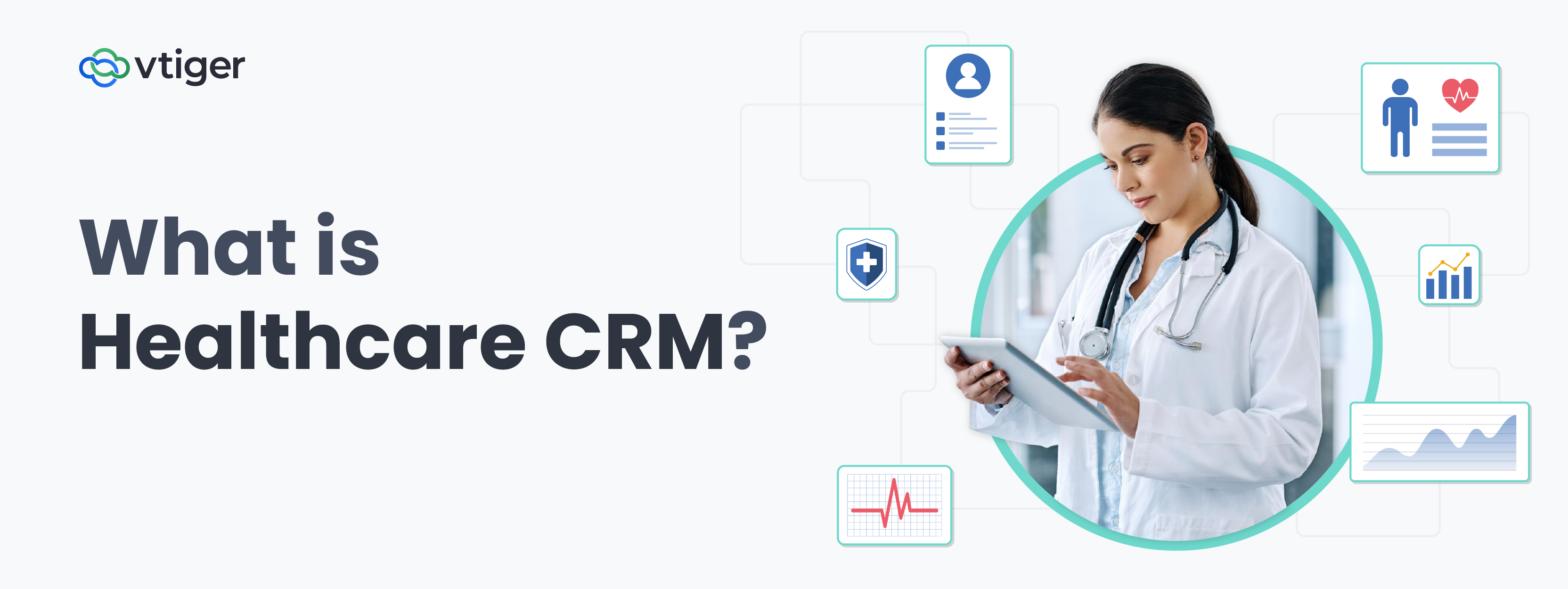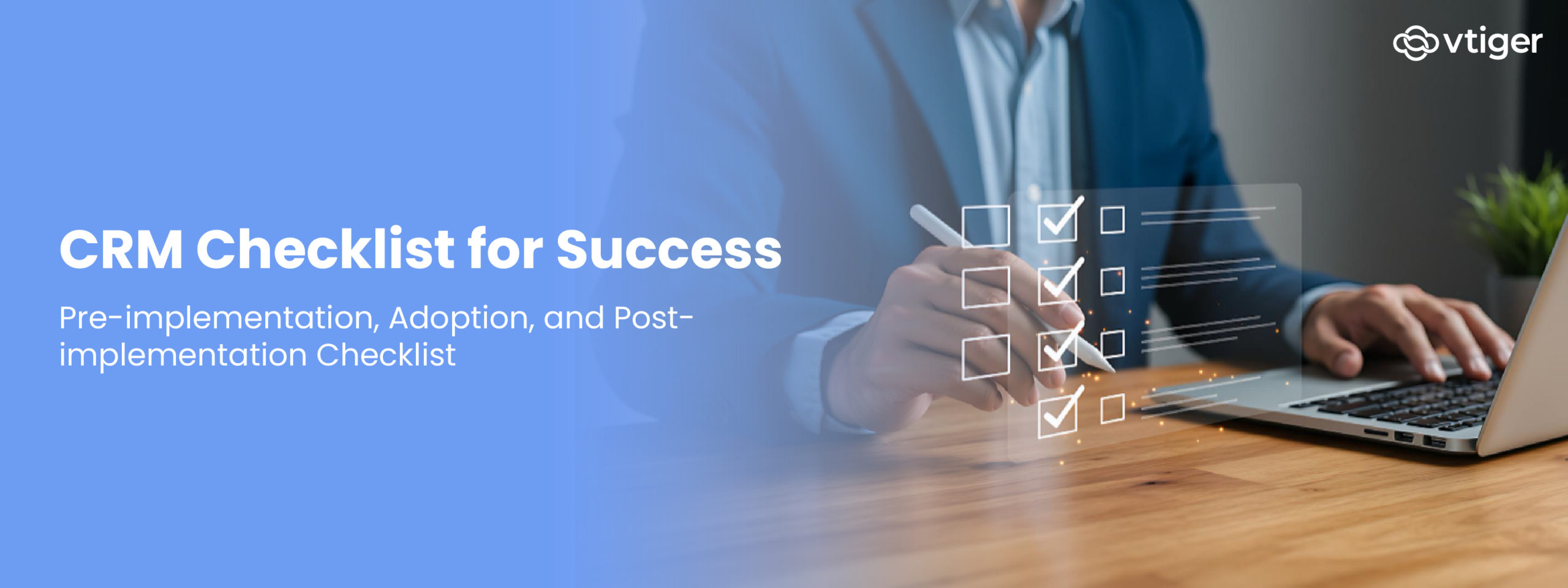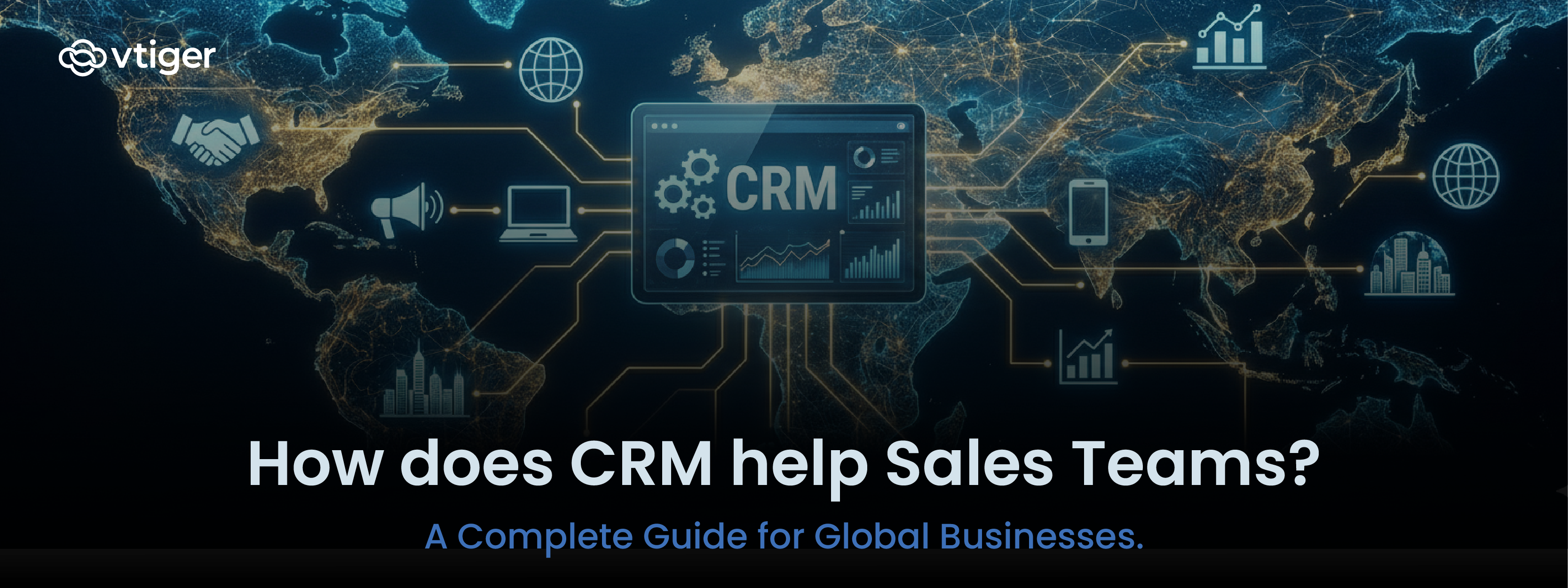Patients today are not just entitled to treatment. They deserve clear communication, timely reminders, and the feeling that their doctor remembers them personally. Hospitals and clinics are trying to catch up with this expectation, and technology is leading the way.
Precedence Research (June 2025) predicts that the healthcare CRM market that was valued at 17.10 billion in 2024, will now flip the script and reach USD 43.4 billion by 2034. This growth is not just about big hospitals spending more; it’s because even smaller clinics are realizing that better patient relationships mean better outcomes and stronger revenue stability.
Read this blog to understand the role of a support system that CRM is currently playing in the healthcare sector.
What Is CRM?
CRM, also known as customer relationship management is designed to help organizations understand and manage their customers better.
In healthcare, this means treating every patient interaction via calls, emails, appointments, as valuable data to improve care and communication. Businesses in other industries already see the benefits; Nucleus Research (May 2024) found that CRM software brings USD 8.71 for every USD 1 invested. For hospitals, this return often shows up as fewer missed appointments, faster service, and patients who choose to return instead of trying a different clinic.
CRMs were once built for retail and finance as sales CRM tools, but healthcare is now adapting them for a much deeper purpose and that is building trust between doctors and patients.
What Is a Healthcare CRM?
A healthcare CRM is an integrated platform designed to manage and optimize patient relationships through all stages of their health journey. It consolidates data from Electronic Health Records (EHRs), billing systems, patient portals, diagnostic centers, and marketing campaigns into a single, actionable database. This unified view enables providers to track patient journeys, automate engagement, and improve care coordination at scale.
Unlike generic CRM software that focuses on lead pipelines or sales conversions, a healthcare CRM is purpose-built for patient acquisition, retention, and experience management. It supports clinical and non-clinical workflows, including appointment scheduling, follow-up reminders, chronic disease management tracking, and targeted outreach for preventive care programs.
The use of healthcare CRMs is increasing because they directly improve patient care. Through personalized engagement, streamlined workflows, and real-time analytics, healthcare CRMs equip providers to improve care quality, achieve higher patient satisfaction, and optimize resource deployment; a set of priorities central to value-driven healthcare.
Who can use healthcare CRM software?
Healthcare CRM software is designed for multi-tier healthcare ecosystems, making it applicable across providers, payers, and ancillary service networks.
- Hospitals and Multispecialty Networks leverage CRM platforms to orchestrate care pathways, manage patient acquisition funnels, and drive post-discharge engagement.
- Outpatient Clinics and Diagnostic Centers use CRMs to reduce appointment churn rates and automate test report dissemination. This helps in running operations smoothly and more quickly.
- Pharmacies integrate CRM modules to manage repeat prescription cycles and monitor patient medication adherence, critical for chronic care management.
- Health Insurance Providers utilize healthcare CRMs to refine member retention strategies and streamline claims lifecycle management through automated communication.
The increase in adoption of cloud-native CRMs is removing infrastructure barriers, enabling tier 2 and tier 3 healthcare facilities to deploy scalable solutions without heavy upfront IT investment.
How does CRM software for healthcare industry function?
Healthcare CRM platforms function as centralized hub to manage all patient interactions relationship orchestration systems. They integrate data streams from Electronic Health Records (EHRs), Laboratory Information Systems (LIS), Practice Management Software (PMS), and billing modules to construct a unified patient repository.
Automation engines within CRMs then execute workflows such as:
- Patient stratification based on clinical risk scores and demographic variables
- Trigger-based appointment scheduling and reminder sequencing to minimize missing out on important activities.
- Automated care plan tracking for chronic disease management
- Personalized outreach campaigns for preventive care and wellness programs
For administrators, a CRM’s real-time dashboard provides operational KPIs such as patient lifetime value (PLV), conversion rates from marketing campaigns, and referral source ROI, making CRMs a strategic decision-support tool as much as a patient engagement system.
10 Healthcare CRM Key Features
A well-implemented healthcare CRM is a care delivery and operational optimization tool. It’s role has now widened beyond being just a repository for patient databases. Below are ten critical features that define a high-performing healthcare CRM and their impact on hospital administration and patient outcomes.
1. Centralized Patient Records
Healthcare CRMs integrate data from EHRs, Laboratory Information Systems (LIS), billing modules, and patient portals into a single record. This centralized repository eliminates duplicate entries, supports care team collaboration, and improves clinical decision-making. Forrester Research (March 2025) reports a 30% increase in care coordination efficiency for hospitals using integrated CRMs.
2. Automated Appointment and Workflow Management
A robust CRM automates scheduling, follow-ups, and discharge workflows, reducing manual administrative burden. Hospitals can configure rule-based triggers to send appointment confirmations and reminders through SMS or email.
3. Patient Stratification and Risk Scoring
Advanced CRMs use predictive modeling to classify patients based on clinical risk, chronic conditions, or treatment compliance history. This helps care managers prioritize serious patients for early intervention.
4. Multi-Channel Patient Communication
Integrated communication modules allow hospitals to engage patients across SMS, email, call centers, and mobile health apps. This ensures consistent outreach for reminders, wellness updates, and feedback collection. Gartner (January 2025) identifies multi-channel engagement as a key differentiator for improving patient retention under value-based care models.
5. Real-Time Analytics and KPI Monitoring
Healthcare CRMs provide executive dashboards tracking metrics such as Patient Lifetime Value (PLV), referral conversion rates, marketing campaign ROI, and care plan adherence levels. These insights guide resource allocation, marketing spend, and physician performance tracking, essential for hospital administrators running multi-specialty or high-volume facilities.
6. Referral and Physician Network Management
CRMs map and track referral patterns, physician relationships, and partner facility performance. This helps hospitals strengthen referral pipelines and identify high-value referral sources, which directly supports revenue cycle optimization.
7. Marketing Automation for Patient Acquisition
Healthcare CRMs run targeted outreach campaigns for preventive screenings, specialty clinics, or new services. Segmentation by age, health condition, or location ensures higher conversion rates and optimized marketing budgets.
8. Feedback and Patient Satisfaction Tracking
CRMs integrate post-care surveys and feedback forms into discharge or follow-up workflows. This continuous tracking of Net Promoter Scores (NPS) and satisfaction indices helps quality teams address service gaps quickly.
9. Data Security and Compliance Management
Enterprise-grade CRMs include HIPAA-compliant data encryption, audit logs, and access control protocols. These features are critical for safeguarding Protected Health Information (PHI) and passing regulatory audits, especially for NABH-accredited and JCI-certified hospitals.
10. Integration with Existing Healthcare IT Systems
The best CRMs offer API-based integration with existing Hospital Information Systems (HIS), Practice Management Software (PMS), and pharmacy management systems. This interoperability prevents data isolation, which ensures smooth information flow between clinical and administrative teams.
10 Benefits of a CRM in Healthcare
Hospitals and clinics adopting healthcare CRMs are reporting measurable gains such as higher patient retention, faster care coordination, and better resource control. The following benefits highlight why these systems are now seen as non-negotiable for competitive healthcare providers.
1. Higher Patient Retention Rates
A well-implemented healthcare CRM improves follow-ups, reminders, and personalized communication, encouraging patients to return for routine check-ups or ongoing treatments. Forrester Research (March 2025) reports a 41 percent increase in patient retention for providers actively using CRM-based engagement programs.
2. Stronger Care Coordination
Healthcare CRM software ensures seamless data sharing between doctors, nurses, and care managers. Integrated workflows reduce delays in decision-making, improving treatment accuracy.
3. Reduced Appointment No-Shows
Automated reminders and scheduling within a healthcare CRM help patients stay informed about upcoming visits, which directly impacts outpatient and diagnostic department utilization.
4. Early Risk Identification
Through the use of predictive analytics, a healthcare CRM system identifies high-risk patients based on medical history and compliance patterns. IBM Watson Health (2024) reports that predictive CRMs reduce risk identification time by 30 percent, enabling timely clinical intervention.
5. Better Patient Experience Scores
Hospitals tracking Net Promoter Scores (NPS) and satisfaction indices through healthcare CRMs can quickly address service gaps. Improved experience scores also impact Hospital Consumer Assessment of Healthcare Providers and Systems (HCAHPS) ratings, which influence both reputation and insurance reimbursements.
6. Optimized Resource Utilization
Healthcare CRM dashboards track bed occupancy, patient flow, and staff workload, helping administrators plan resources effectively. This improves operational efficiency, especially in high-volume outpatient departments.
7. Cost-Effective Patient Acquisition
Segmentation features in healthcare CRM software allow targeted campaigns for preventive screenings, chronic care programs, or specialty services. Focused outreach improves conversion rates and optimizes marketing budgets, reducing overall acquisition costs.
8. Strengthened Referral Network
Tracking referral sources and physician relationships through a CRM helps hospitals focus on high-performing referral channels. This directly supports revenue cycle optimization and builds stronger ties with referring physicians and partner facilities.
9. Better Compliance and Data Security
Advanced healthcare CRM systems are built with HIPAA-compliant encryption, audit tracking, and role-based access controls. These features reduce compliance risks for NABH-accredited and JCI-certified hospitals, where data security is a mandatory requirement.
10. Support for Value-Based Care Models
Value-based care depends on continuous patient monitoring, treatment adherence, and population health tracking. Healthcare CRM software aligns with these goals by providing care plan adherence tracking and personalized outreach, resulting in fewer readmissions and better clinical outcomes.
What Are the Drawbacks of a Healthcare CRM?
While a healthcare CRM offers measurable benefits, its adoption is not without challenges. The following list of drawbacks often influences budgeting, implementation speed, and its operational efficiency:.
1. Initial Investment and Ongoing Costs
Deploying a healthcare CRM software involves costs for licensing, customization, hardware support, and periodic maintenance. Larger hospitals often allocate dedicated IT budgets, but smaller clinics or facilities in tier 2 and tier 3 cities may find it challenging to justify the initial investment without a clear ROI plan.
In addition, ongoing expenses for software updates and user support require consistent budget allocation. Many healthcare administrators mitigate this by opting for modular CRM implementations, right from starting with patient engagement or appointment management modules before scaling up to advanced analytics.
2. Integration with Existing Healthcare Systems
Most hospitals already operate multiple platforms, including Electronic Health Records (EHRs), Hospital Information Systems (HIS), billing software, and diagnostic lab systems. Integrating a new CRM into these existing workflows can be technically demanding. If done hastily, it can lead to duplicate patient entries, inconsistent medical records, and workflow disruptions. A planned approach, involving phased integration and pilot testing, helps minimize these risks. Collaboration between the CRM vendor and the hospital’s IT team is essential to ensure data consistency and interoperability.
3. Training and Staff Adaptation
The success of a healthcare CRM depends on how well staff members adopt it. Doctors, nurses, and administrative teams are often accustomed to existing workflows, and introducing a new system can initially feel like an added burden. Without proper onboarding, teams may underutilize key features, limiting the system’s impact. Hospitals with successful CRM adoption typically conduct role-based training sessions and appoint CRM experts within departments to guide others. Gradual implementation also helps staff adjust without feeling overwhelmed.
4. Dependence on Accurate and Complete Data
The effectiveness of predictive analytics, patient segmentation, and engagement campaigns in a CRM depends entirely on the quality of the data entered. Incomplete or outdated patient information can result in incorrect risk scoring, irrelevant automated messages, or misdirected marketing campaigns. To prevent this, hospitals must establish strict data governance practices, assign responsibility for data validation, and encourage clinical and administrative teams to update records regularly.
5. Balancing Automation with Personalized Care
Automation is one of the biggest advantages of a healthcare CRM system, but excessive reliance on automated messages can make patient communication feel impersonal. Generic reminders or poorly timed wellness campaigns may disengage patients rather than build trust. Hospitals need to design personalized communication workflows, combining automation for routine updates with human-led interactions for sensitive or high-priority cases. This balance is especially important for specialty care facilities where patient trust plays a critical role in treatment adherence.
6. Gradual Return on Investment (ROI)
Unlike financial systems, where ROI is visible within months, a healthcare CRM shows results progressively. Improvements in patient retention, satisfaction, and care coordination accumulate over time. Hospitals expecting immediate revenue growth may view this as a drawback. To address this, administrators should set realistic KPIs such as tracking reduced no-show rates or improved appointment adherence, as early indicators of success before measuring long-term financial returns.
7. Dependence on Vendor Support and Updates
Healthcare CRMs require regular updates to maintain security, improve performance, and add new features. Hospitals remain dependent on vendors for timely updates, troubleshooting, and feature enhancements. A delayed software patch or slow response to technical issues can affect daily operations. Choosing a vendor with proven healthcare experience and strong after-sales support minimizes such risks. Administrators should also establish Service Level Agreements (SLAs) to ensure response time commitments.
These challenges are not reasons to avoid adopting a healthcare CRM but areas that demand proper planning. A phased approach, strong training programs, and collaboration with experienced CRM vendors ensure that the benefits of healthcare CRM software far outweigh these initial hurdles.
Healthcare CRM vs. EHR
A healthcare CRM and an Electronic Health Record (EHR) system perform complementary but clearly distinct roles in a healthcare setup.
An EHR is designed for clinical documentation. It records a patient’s complete medical history, diagnostic results, prescriptions, and treatment progress. Physicians and clinical staff use EHRs primarily to ensure accurate diagnosis, track treatment outcomes, and comply with regulatory standards. Its purpose is clinical accuracy rather than patient relationship management.
A healthcare CRM software, in contrast, focuses on patient engagement and operational efficiency. It manages appointment scheduling, follow-up reminders, referral tracking, and communication campaigns while providing analytics for patient retention and resource planning. Its primary users are hospital administrators, marketing teams, and patient relationship managers, although doctors often use CRM dashboards for better follow-up coordination and improved patient experience.
EHRs are mandatory for clinical care and form the backbone of treatment documentation. CRMs are now considered strategic tools for value-based care, where improving patient satisfaction, reducing no-shows, and optimizing resource utilization directly influence both clinical outcomes and revenue. Hospitals achieve maximum efficiency when EHRs and CRMs are integrated, enabling clinical data and engagement insights to work together for a timely delivery experience.
Healthcare CRM vs. EHR – Quick Comparison
| Aspect | Healthcare CRM | EHR (Electronic Health Record) |
| Primary Purpose | Patient engagement, relationship management, and operational efficiency | Clinical documentation and medical record management |
| Key Users | Administrators, marketing teams, patient relationship managers, and sometimes doctors | Doctors, nurses, and clinical staff |
| Core Functions | Appointment scheduling, follow-ups, referral tracking, patient segmentation, and analytics | Recording medical history, diagnostic results, treatment plans, and prescriptions |
| Goal | Improve patient satisfaction, retention, and resource utilization | Ensure clinical accuracy, regulatory compliance, and care continuity |
| Role in Value-Based Care | Essential for improving patient experience and adherence to care plans | Essential for accurate clinical decision-making |
| Integration Benefit | Enhances follow-up and personalized care using clinical insights | Gains operational efficiency and patient relationship visibility when integrated with CRM |
Implementing a Healthcare CRM System
A well-planned healthcare CRM implementation ensures that hospitals can use technology to improve patient engagement and streamline operations without disrupting existing workflows. Each stage requires clear planning, proper resource allocation, and staff involvement.
1. Setting Defined Goals
Hospitals must start by identifying what they want to achieve. For a tertiary care hospital, the priority may be coordinated care and post-discharge follow-ups, while a small clinic may aim to increase appointment adherence and manage patient queries effectively. These defined goals act as the baseline for selecting the right features and measuring performance later.
2. Selecting the Right CRM Model
Choosing between a proprietary system and an open source CRM depends on scale and technical resources. Proprietary platforms are suitable for hospitals needing ready-to-use healthcare modules, automated reporting, and vendor support. Open source CRM software works better for mid-sized providers who have in-house IT teams capable of tailoring workflows to local needs. Whichever option is chosen, the system should support secure data handling, regulatory compliance, and easy scalability.
3. Planning Data Migration and System Integration
Smooth integration with EHRs, Hospital Information Systems (HIS), billing, and lab management software is essential for accurate patient records. Hospitals should adopt a phased migration plan to standardize data, test accuracy, and avoid duplication. Running a pilot in one department before expanding across the facility helps identify technical gaps early.
4. Training and Staff Engagement
The success of a healthcare CRM depends on how effectively staff use it. Training should be role-specific, with separate sessions for administrative teams, clinicians, and marketing personnel. Creating departmental leads to monitor adoption and assist other staff improves confidence and reduces resistance to new processes.
5. Establishing Performance Metrics
Hospitals should track measurable outcomes to assess ROI. Key metrics include patient satisfaction scores, follow-up completion rates, referral conversion, and reduction in appointment no-shows. Reviewing these indicators monthly allows administrators to fine-tune workflows.
6. Continuous Evaluation and Updates
Implementation does not end at deployment. Periodic reviews, staff feedback, and vendor consultations help refine processes. As patient volumes grow, hospitals can add advanced features such as AI-driven segmentation or predictive care models to strengthen engagement.
Conclusion
Hospitals and clinics can no longer depend only on EHRs or manual processes if they want to meet today’s patient expectations. People now look for quick responses, regular follow-ups, and smooth coordination between departments. A well-implemented healthcare CRM makes this possible by improving how patients are managed and how care teams work together.
With healthcare steadily moving toward value-based care, the real question for providers is not whether they need a CRM but how soon they can adopt it to stay ahead and deliver better patient experiences. Vtiger is here to make that transition easier and feature-ready, as our CRM solutions will make your provider’s office workflows more vigilant and cost-effective.
Frequently Asked Questions
It is a software solution built specifically for hospitals and clinics to manage patient interactions, track engagement history, and analyze care delivery patterns. Its purpose goes beyond storing data; it supports relationship-driven healthcare.
Hospitals are moving to value-based care, where patient experience directly affects outcomes and revenue. CRM software enables consistent follow-ups, reduces communication gaps, and helps align clinical teams with administrative workflows.
No. Healthcare demands CRMs that support secure patient data handling, care-specific workflows, and integration with medical systems. Generic CRMs lack healthcare-grade compliance and risk disrupting established processes.
Look for patient tracking across touchpoints, care coordination modules, analytics for engagement trends, and easy interoperability with EHRs. These functions ensure that the CRM supports both administrative and care teams effectively.
By mapping patient journeys and ensuring timely updates, CRMs create a structured communication flow. Patients receive relevant reminders and personalized support, which strengthens trust and improves their response to treatment plans.
It replaces fragmented manual tracking with centralized workflows. Staff can monitor appointments, referrals, and patient follow-ups from a single interface, reducing administrative delays and improving resource allocation.
Yes. Hospitals should ensure the CRM uses role-based data access, encrypted storage, and complies with many regulatory bodies or local health data protection regulations to prevent breaches.
Adoption may face workflow disruptions, resistance from staff, and data migration errors if not planned properly. A phased rollout with vendor-led training usually addresses these issues.
EHRs document clinical history, while CRMs manage patient relationships. Together, they provide both medical accuracy and engagement continuity, which are equally important for value-based care.



